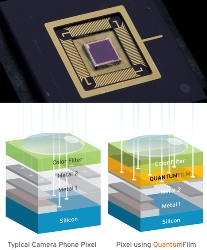Mar 22 2010
Ushering in a new era of high-performance image sensors, InVisage Technologies, Inc. -- a venture-backed start-up that is revolutionizing the way light is captured -- today announced QuantumFilm.
 QuantumFilm image sensor
QuantumFilm image sensor
Harnessing the power of custom-designed semiconductor materials, QuantumFilm image sensors are the world's first commercial quantum dot-based image sensors, replacing silicon. InVisage delivers 4x higher performance, 2x higher dynamic range and professional camera features not yet found in mobile image sensors. The first QuantumFilm-enabled product, due out later this year, solves the crucial challenge of capturing stunning images using mobile handset cameras.
QuantumFilm was developed by InVisage after years of research under the guidance of notable scientist and InVisage CTO Ted Sargent. The technology is based on quantum dots -- semiconductors with unique light-capture properties. QuantumFilm works by capturing an imprint of a light image, and then employing the silicon beneath it to read out the image and turn it into versatile digital signals. InVisage spent three years engineering the quantum dot material to produce highly-sensitive image sensors that integrate with standard CMOS manufacturing processes. The first application of QuantumFilm will enable high pixel count and high performance in tiny form factors, breaking silicon's inherent performance-resolution tradeoff.
"It is becoming increasingly difficult and expensive to develop next-generation image sensors using silicon; essentially, silicon has hit a wall," says Jess Lee, InVisage President and C.E.O. "The fundamental problem is that silicon cannot capture light efficiently, but until now it has been the only option. The disruptive nature of QuantumFilm builds on silicon's success in electronics, and elevates its function using new materials that are engineered from the ground up for light capture."
Silicon-based image sensors -- the technology used today for all digital cameras including handheld, professional, mobile phone, security and automotive cameras -- capture on average a mere 25 percent of light. QuantumFilm captures between 90-95 percent, enabling better pictures in even the most challenging lighting conditions. This increase in efficiency will deliver improvements across the entire imaging market, allowing QuantumFilm to be the de-facto next generation camera platform. The first target market for QuantumFilm is mobile handsets, where there is the greatest demand for small, high performance image sensors.
Just nanometers in size, the quantum dot-based material is deposited directly on top of the wafer during manufacturing. And unlike silicon-based image sensor technologies such as BSI (back-side illumination) and FSI (front-side illumination), QuantumFilm covers 100 percent of each pixel. The material is added as a final wafer-level process, which allows for easy integration into standard semiconductor foundries. The process -- akin to coating a layer of photoresist onto a standard wafer -- adds minimal cost on top of the standard layers of silicon processes.
"It is safe to say that the industry spends an average of $1 billion for each new generation of pixel technology, all to achieve a single-digit percentage improvement in image quality," says Tetsuo Omori, senior analyst, Techno Systems Research Co. "The future of imaging is in new materials like QuantumFilm, which will change the competitive landscape and possibly re-ignite the pixel race."
InVisage was founded in 2006 and is led by industry veterans from the image sensor and advanced semiconductor materials industry. It employs 30 people at its Menlo Park headquarters and has received more than $30 million in funding from RockPort Capital, Charles River Ventures, InterWest Partners and OnPoint Technologies. Its technology is protected by 21 patents and patents pending.
QuantumFilm is ideal for a wide range of image-sensing technologies including security cameras, automotive cameras and military applications. The first QuantumFilm image sensors, targeting high-end mobile handsets and smartphones, will sample in Q4 of 2010.
Source: http://www.invisageinc.com/